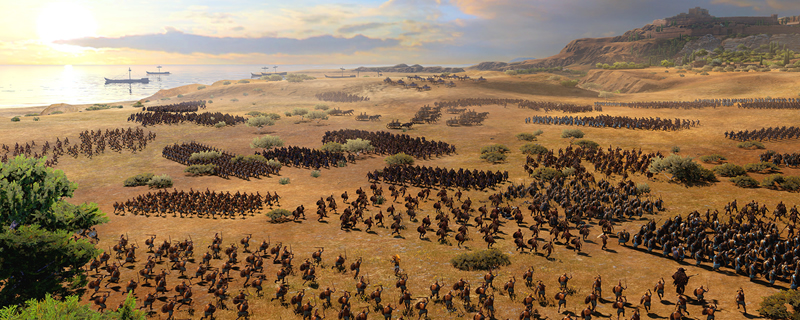A Total War Saga: Troy PC Performance Review and Optimisation Guide
Conclusion
When it comes to PC performance, there is very little to complain about with A Total War Saga: Troy, with our only niggle being Creative Assembly’s insistence that 4x MSAA be enabled within this game’s Ultra Preset. This setting is a performance killer, and should only be used by those who have the GPU power to spare, and when the game already offers above Ultra settings, there is little reason for 4x MSAA to be within any of the game’s graphical presets.Â
Based on our experience with the Total War franchise, and the game’s lack of TAA, it looks like A Total War Saga Troy is based on the engine of Total War: Warhammer II, not Total War Three Kingdoms. This engine choice makes sense given the budget nature and shorter development cycles of Total War Saga titles, but it leaves Troy in a position where the game is more limited than it could have been. The use of an older Total War engine is not necessarily a bad thing, as A Total War Saga: Troy still looks and runs well across a wide variety of PC hardware configurations. PC gamers just shouldn’t be expecting Total War: Three Kingdoms visuals here.Â
Hardware-wise, most PC gamers with relatively modern PCs should be able to run A Total War Saga Troy using the game’s high preset at 1080p with great framerates. At 1440p, users of graphics cards like AMD’s RX 5600 XT and Nvidia’s RTX 2060 will also get solid 60 average framerates at these settings.Â
For those with ultra-high-end PCs, A Total War Saga: Troy also has higher than Ultra graphical settings to explore, allowing gamers to expand unit sizes to ludicrous levels, making battles larger and more climactic. Be warned that using these settings will cause CPU-limited performance in many areas, especially during battles with multiple allied or enemy armies. Our CPU performance data comes from a typical battle size, and even then constant 60 FPS performance can be hard to achieve with Extreme unit sizes.Â
CPU-wise, we found that while A Total War Saga Troy tried to use all sixteen of our Ryzen 9 3950X’s cores, that the game didn’t benefit from having more than six cores and twelve threads active. In the campaign map, the game preferred having only one CPU die of our Ryzen 9 3950X active, and the game’s battle more didn’t like it when we disabled SMT on our Ryzen 9 3950X when four cores were active. Perhaps A Total War Saga: Troy needs to become more Ryzen-aware, but that didn’t stop the game from providing strong performance anyway. Remember that this game’s engine doesn’t appear to be the same as Total War: Three Kingdoms.Â
If you want optimisation tips, our advice is to immediately disable MSAA (2x/4x AA) is you want to boost Troy’s GPU performance. Disabling MSAA alone increased the average framerates of our RTX 2060 from 45.7 FPS to 67.9 FPS at 1440p, delivering a performance increase of 48.5%. Outside of this, turning down the game’s Grass, Shadows and Ambient Occlusion settings appear to have the largest performance impact in most scenes.Â
Like all Total War games, A Total War Saga Troy is a game with two halves. There’s the turn-based campaign map, and there is the real-time battle mode. Both modes have different performance profiles, and players should have the option to change game settings on a per-mode basis. A Total War Saga: Troy’s campaign map runs significantly better than the game’s battle mode, which means that some players would love to use different in-game settings for each mode. For their next Total War game, Creative Assembly should allow players to change their graphics settings on a pre-mode basis. Obviously, parameters like unit size need to be the same for both modes, but outside of that, a lot of these settings could change.Â
Hardware-wise, we found it very interesting to see how AMD’s RDNA graphics cards compared to AMD’s older Polaris and Vega GPUs in Troy’s battle mode. AMD’s RDNA graphics cards very very competitive with Nvidia’s offerings while AMD’s older cards were behind their Nvidia rivals. This change shows that AMD’s RDNA architectural enhancements have been moving Radeon’s hardware in the right direction. Let’s hope that this shift will continue with RDNA 2.Â
Outside of a few petty niggles, there is little to complain about when it comes to A Total War Saga: Troy’s PC performance. While we would love to see more performance scaling from our 16-core Ryzen 9 3950X, DirectX 12/Vulkan API support, and the option to use TAA as an alternative to the game’s ultra-demanding MSAA, none of these factors stops us from achieving strong performance with our PC hardware. Â
A Total War Saga: Troy is an incredibly scalable game, allowing the game to be enjoyed across a wide range of both new and old gaming hardware. Even so, the game’s beyond-Ultra settings will allow gamers to stress their gaming hardware well into the future.Â
This may not be the best looking Total War or the most expansive release for the franchise, but it’s more Total War goodness to enjoy and it runs well on today’s PC hardware.Â
You can join the discussion on A Total War Saga: Troy’s PC performance on the OC3D Forums.Â



